



Orego-Stim for the Broiler Withdrawal Feed Period
The use of Orego-Stim® during the withdrawal feed period has been proven to be effective in the control and prevention of gastrointestinal tract diseases such as coccidiosis and necrotic enteritis, according to Meriden Animal Health in its Technical Bulletin no. 8.Introduction
The withdrawal feed period of broilers is defined as the specific period when in-feed antimicrobials are excluded from the feed of broilers to allow for the complete elimination of drug residues from the tissues of the bird prior to slaughter.
This period leaves the bird open and susceptible to outbreaks of disease such as coccidiosis and necrotic enteritis, which proves to be a constant challenge faced by broiler producers worldwide.
In-Feed Antimicrobials
Antimicrobials used in poultry feed can be categorised into two main groups. Feed additives are those that are used for growth promotion and as anticoccidials and are added to feed without a veterinary prescription, whereas medicated feed are those used for treatment of diseases which could only be added to feed with a veterinary prescription. From 1 January 2006, the EU has banned the use of antibiotic growth promoters (AGPs) in poultry feed.
In most parts of the world, the majority of antibiotic growth promoters are added to feed without a veterinary prescription but at specified levels. Often, a low level inclusion rate is used for growth promotion purposes, intermediate levels for prevention of disease and high levels for treatment. In the EU, this is considered as a very liberal use of antimicrobials and there is genuine concern that this could potentially lead to overuse and the unnecessary development of antimicrobial resistance. This resistance could be transmitted to Man either via zoonotic infections, such as Salmonella spp. and Campylobacter spp. or by commensal organisms carrying resistance plasmids, which if consumed, might pass the resistance on to human intestinal flora and interfere with the treatment of disease in humans.
Initially, the primary concern began over the use of avoparcin in humans for severe life-threatening infections caused by enterococci, especially in immuno-compromised patients, whether from infection (HIV), from cancer treatment or following transplant surgery. Avoparcin was frequently used in the livestock industry and is related to vancomycin. When vancomycin-resistant enterococci (VRE) began to surface in human cases, it was thought that it could be related to the use of avoparcin in animals. The potential risk of resistance transmission from animals to Man via commensals is very difficult to prove or quantify, but with better genetic identification of bacteria within species, it is increasingly proven to be a very low risk, especially for VRE as they are primarily associated with iatrogenic or hospital-derived epidemic strains. However, as a precautionary measure and to avoid the risk of this happening, the EU has banned a number of antibiotic growth promoters used in the livestock industry in the 1990s as they were somewhat related to antibiotics used in humans. Some examples of these are:
- avoparcin (vancomycin)
- virginiamycin (quinupristin)
- tylosin and spiramycin (macrolides/erythromycin)
- bacitracin (bacitracin)
Other compounds, which had safety concerns and were thought to be potential carcinogens, were also banned from use. These include nitroimidazoles such as dimetridazole and ronidazole, and also the quinoxaline derivatives olaquindox and carbadox.
From 1 January 2006, the EU banned the remaining antibiotic growth promoters and these included avilamycin, flavophospholipol and the ionophores, monensin for cattle and salinomycin for pigs. The ionophores remained as prescription-free feed additive anticoccidials for use in poultry. All of these compounds are not currently used in human medicine, so the decision can be questioned even further on a scientific risk-analysis or precautionary basis and is considered to be more politically based.
Antibiotic Growth Promoters & Their Effects
Antibiotic growth promoters have two major effects:
- To improve production parameters, that is, to improve growth rate and feed conversion efficiency by exerting an antimicrobial affect on commensal bacteria, hence their nutrient-sparing effect.
- As antimicrobials, some AGPs have an effect against pathogenic organisms and can primarily prevent enteric diseases.
Although AGPs were mostly not directly active against Escherichia coli, they seemed to reduce the incidence of collibacillosis in poultry to a certain extent. Many also had potent activity against Clostridium perfringens, which is currently one of the main concerns of poultry producers worldwide.
Salinomycin, which has been the major growth promoter for farms with a history of coccidiosis, will continue to be used and play a crucial role in the control and prevention of the disease. Broiler producers will persistently continue to use this ionophore as long as they are legally allowed to do so.
The Usage of Antibiotics in Feed: A Reduction or an Increase?
Will the ban on antibiotic growth promoters in livestock feed have the desired effect of reducing the overall level of antimicrobial use in livestock animals? At the moment, this looks to be highly unlikely, as statistics continue to show a drastic increase in the use of in-feed antimicrobials used for therapeutical purposes, even though there is a significant reduction in the usage of antibiotic growth promoters.
The escalating usage of treatment antibiotics is imperative for the effective control of prevalent poultry diseases such as coccidiosis and necrotic enteritis, which have serious consequences and may badly affect production performance.
From a veterinary standpoint, removing in-feed anticoccidials may open the door to more enteric pathogens. Most feed mills compensate by making adjustments to the nutritional programmes of the broilers. Nevertheless, however sterile or effective the feed formulation is in terms of nutritional balance and design, it can never replace the ease and efficiency of using an anticoccidial in controlling or preventing a disease outbreak.
The Resistance Problem
Whether they are being forced by legislation or simply seeking to meet consumer demands for safer and healthier food, most broiler producers worldwide have made it their most immediate goal to stop the continuous use of in-feed antibiotic growth promoters and anticoccidials, and to reverse what management felt was a growing resistance problem. Many feed and broiler veterinarians have noticed that some anticoccidials were simply not working as well as they used to.
Even though anticoccidials are used in carefully-planned shuttle programs, the main concern was that more pathogenic strains of Eimeria were developing and that the disease would become more difficult and costly to control. In flocks with sub-clinical coccidiosis, the average daily gain and feed conversion can be severely affected by the disease. Certain changes are necessary to prevent the occurrence of any major setbacks and to give traditional anticoccidials a much needed rest.
The Changing Needs of the Modern Consumer
Consumers today take a lot of interest in how their food is raised. Whether their concerns have scientific merit or if they are simply responding to a story they read in a newspaper, we know they are worried about drugs in animal feed. Broiler producers today need to be sensitive to consumer demands.
The boost in anticoccidial performance has been especially helpful following the EU’s ban of nicarbazin in May 2002. Nicarbazin was routinely used in shuttle programmes and helped the in-feed anticoccidials work better. Without this additive, we need to be more careful with the anticoccidials that are still available to us.
Orego-Stim®: The Natural Wonder
Orego-Stim® is a natural, phytogenic feed additive and continues to be the market leader amongst all other essential oils in the livestock industry.
The composition of the oil consists predominantly of a unique ratio and concentration of the natural phenolic compounds, carvacrol and thymol, which are known to be powerful antimicrobial agents. Phenols kill organisms such as bacteria through its toxic effect on the cell wall, by denaturing and coagulating the proteins within the cell wall structure. The increase in permeability causes leakage of cellular constituents, resulting in water imbalance and cell death.
Orego-Stim has also been proven to contain anticoccidial properties. In the normal intestinal mucosa, the epithelial lining is regularly shed and replacement occurs by cell division from within the crypts. Phenols act on the gut lining by increasing the rate of enterocyte turnover by about twice the normal rate.
The phenolic compounds in Orego-Stim disrupt the life cycle of coccidian parasites by speeding up the rate of shedding of the gut lining. Through this mode of action, intracellular coccidial sporozoites are shed before they have the opportunity to penetrate deeper into the gut wall or form new oocysts. Coccidiosis is therefore prevented or controlled by creating an environment that is hostile to the completion of the life cycle of the parasite. This mode of action is similar to that of ionophores such as salinomycin and monensin, which have been used as antibiotic growth promoters as well as coccidiostats worldwide.
In contrast to antibiotic growth promoters and coccidiostats, there has been no evidence of development of bacterial resistance from using Orego-Stim simply because its inhibitory effect on bacteria is due to its phenolic mode of action, and not through the transfer of any chromosomes. Its mode of action on the enterocytes also ensures that all species of Eimeria are constantly shed and removed from the intestines to effectively and continuously prevent coccidiosis.
Orego-Stim is not absorbed through the intestines into the bloodstream, so there are no residues in livestock products such as meat or eggs. This means that no withdrawal period is necessary and Orego-Stim can be used right up to the slaughter period.
When incorporated into livestock diets, Orego-Stim has been shown to improve palatability, feed intake, FCR and growth rates. Extensive in vitro and in vivo trials have proven that Orego-Stim assists in alleviating problems associated with the presence of gastrointestinal pathogens such as E. coli, Salmonella spp., Clostridium perfringens and Eimeria spp. These pathogens may otherwise cause diarrhoea, weight loss, poor uniformity and death in livestock animals, leading to significant economic losses for producers.
The Use of Orego-Stim During the Broiler Withdrawal Feed Period
Using Orego-Stim as part of the anticoccidial shuttle programme and during the withdrawal feed period in broilers helps to keep the anticoccidials working. Traditional anticoccidials such as salinomycin and naracin perform better when used in a rotation scheme with Orego-Stim. This is because when the former is rested and whilst Orego-Stim is being used as an anticoccidial, the protozoan parasites regain their sensitivity towards the anticoccidials. This helps to prolong their efficacy and reduces risks of premature development of resistance.
Throughout the world, Orego-Stim is expected to play an even bigger role in the future as more and more poultry companies see how its inclusion during the withdrawal feed period can add flexibility to nutritional programmes and how it benefits the overall flock health by the control and prevention of diarrhoea-related diseases of the gastrointestinal tract, which is directly linked to the efficiency of the digestion and absorption process. This in turn greatly influences feed conversion efficiency and determines whether a producer makes a profit or a loss.
Because birds on Orego-Stim are free from the constraints imposed by drug withdrawal times, companies can build feed programmes around the nutritional needs of the birds, not the withdrawal times of in-feed anticoccidials. For example, instead of feeding a withdrawal or finisher feed to the birds for the last five to six days, some companies are resorting to using Orego-Stim with this feed much earlier in the flock’s life, possibly at 30 days, to maximise the potential of this explosive growth period of rearing without risking a late coccidiosis outbreak. Extending the withdrawal feed period is something most companies are working on, whilst at the same time producing a very high quality carcass.
Prior to the withdrawal feed period, most broiler producers also want to keep the antibiotic growth promoters in the feed while it is still available to them. But the ones who know and have discovered the growth-enhancing effects of Orego-Stim have certainly seen the latest research in this area of broiler nutrition. Extending the time for the usage of lower-costing withdrawal feed together with the inclusion of Orego-Stim is currently an exciting, short-time, high profit-yielding strategy for global consideration.
Orego-Stim also has one more significant benefit, which is greater marketing flexibility. When birds are protected from coccidiosis and necrotic enteritis by Orego-Stim, the farm manager does not have to worry about withdrawing medication from the feed and leaving birds unprotected. Hence all the broilers can be put on the same feed and lighter birds can be marketed whenever they are in demand, making the programme much easier to manage.
Preventing coccidiosis with Orego-Stim will also help poultry producing companies to reduce drug usage without compromising the health or the performance of the birds. Orego-Stim even helps to eliminate subclinical coccidiosis problems. And when the flock is free from coccidiosis, the birds will most certainly perform better in all areas of production.
Orego-Stim Trial During The Withdrawal Feed Period Of Broilers
Bey Piliç is one of the largest and leading poultry integrators in Turkey. A trial was conducted in one of the Bey Piliç broiler farms located in Bolu in June 2003. The aim of this trial was to evaluate the effect of Orego-Stim on broiler performance during the withdrawal feed period from days 35 to 42, when no antibiotic growth promoters or coccidiostats were used in the feed.
A total of 142,706 birds were divided into two groups; 111,154 birds in the Orego-Stim group and 31,552 in the control group. The birds had pasty vents and clinical signs of diarrhoea, despite having coccidiostats in their feed prior to the withdrawal feed period. This is suspected to be due to the emergence of resistance towards the coccidiostats used in this farm.
 |
 |
 |
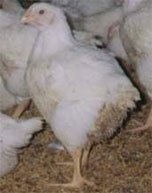 |
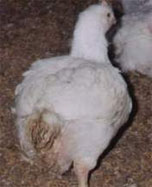 |
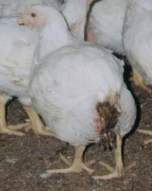 |
| Figure 1. Clinical evaluation of the broilers before the application of Orego-Stim | |
The faecal droppings were mucoid to watery, with blood stains that were typical of a necrotic enteritis infection. Some birds were not eating, as displayed by the bile-stained faecal droppings. There was evident poor digestion and notable traces of undigested corn in the faeces.
 |
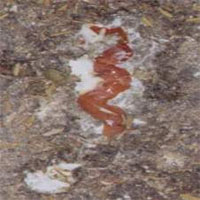 |
 |
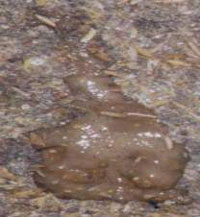 |
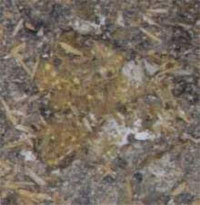 |
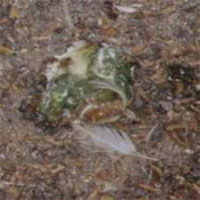 |
| Figure 2. Clinical evaluation of the faeces before the application of Orego-Stim | |
Orego-Stim Liquid® was administered during this withdrawal feed period from days 35 to slaughter at day 42, via the drinking water at an inclusion rate of 150 to 250ml per 1,000 litres of drinking water, depending on the condition of the litter and the faeces.
At the end of the one-week trial period, there was a vast improvement in the condition of the birds. The diarrhoea stopped and the faecal droppings returned to their normal solid shape and texture.
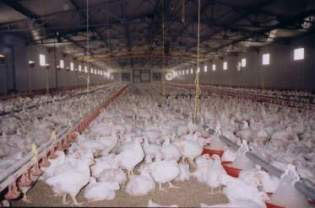 |
|
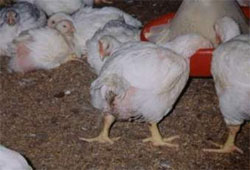 |
 |
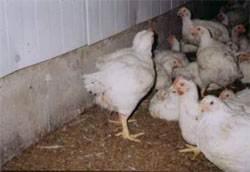 |
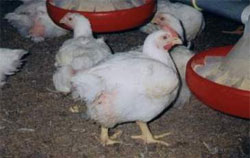 |
| Figure 3. Clinical evaluation of the broilers after the application of Orego-Stim | |
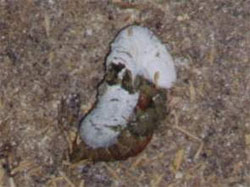 |
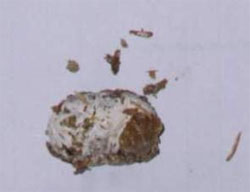 |
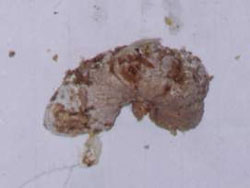 |
 |
| Figure 4. Clinical Evaluation of the faeces after the application of Orego-Stim | |
The trial results showed that the birds on Orego-Stim were heavier than the control group by 58 grams per bird.
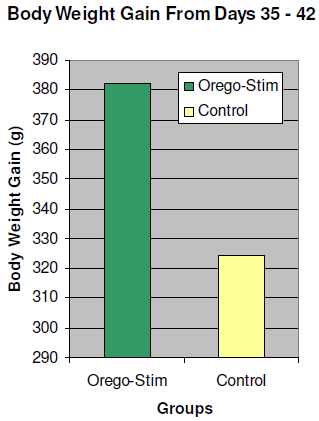
The Orego-Stim group also showed improvements in terms of feed conversion, with an FCR of 1.851 compared to 1.913 in the control group.

With regard to mortality, the number of deaths recorded in the trial period was 1.03 per cent in the Orego-Stim group, compared to 2.32 per cent in the control group.
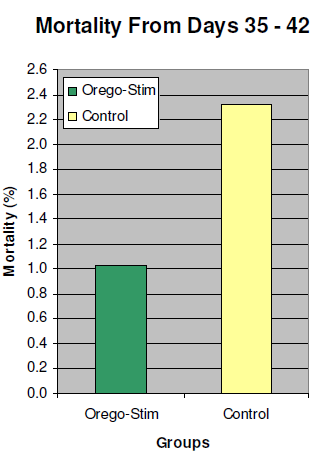
A cost analysis of this seven-day trial revealed that the extra profit generated from the Orego-Stim group was US$0.12 per bird. This further converted to a total net profit of US$13,318.80, simply by using Orego-Stim Liquid for a week during the withdrawal feed period.

Conclusion
In the competitive world of broiler production, the usage of Orego-Stim during the withdrawal feed period has been proven to be effective in the control and prevention of gastrointestinal tract diseases such as coccidiosis and necrotic enteritis, which continue to threaten the livelihood and earnings of broiler producers worldwide.
When used during this period, Orego-Stim yields a higher profit for the producer and maximises the return on investment by improving production parameters and performance, regardless of varying farm conditions.








